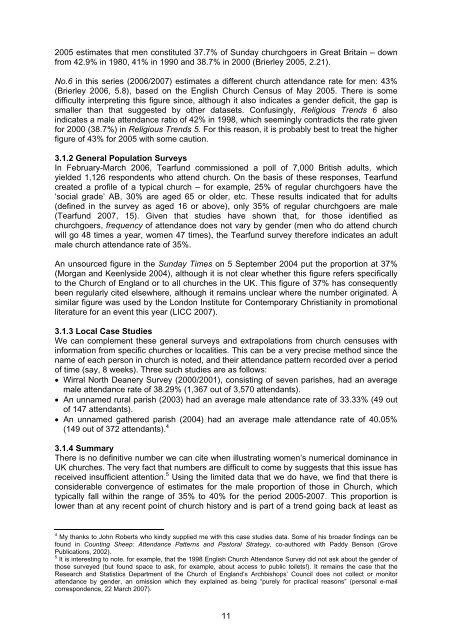Disbanded Brothers – Has a ‘Feminised’ Church Alienated Men in the UK?
Disbanded Brothers - Has a 'Feminised' Church ... - Theduckers.org
Disbanded Brothers - Has a 'Feminised' Church ... - Theduckers.org
- No tags were found...
Create successful ePaper yourself
Turn your PDF publications into a flip-book with our unique Google optimized e-Paper software.
2005 estimates that men constituted 37.7% of Sunday churchgoers <strong>in</strong> Great Brita<strong>in</strong> <strong>–</strong> down<br />
from 42.9% <strong>in</strong> 1980, 41% <strong>in</strong> 1990 and 38.7% <strong>in</strong> 2000 (Brierley 2005, 2.21).<br />
No.6 <strong>in</strong> this series (2006/2007) estimates a different church attendance rate for men: 43%<br />
(Brierley 2006, 5.8), based on <strong>the</strong> English <strong>Church</strong> Census of May 2005. There is some<br />
difficulty <strong>in</strong>terpret<strong>in</strong>g this figure s<strong>in</strong>ce, although it also <strong>in</strong>dicates a gender deficit, <strong>the</strong> gap is<br />
smaller than that suggested by o<strong>the</strong>r datasets. Confus<strong>in</strong>gly, Religious Trends 6 also<br />
<strong>in</strong>dicates a male attendance ratio of 42% <strong>in</strong> 1998, which seem<strong>in</strong>gly contradicts <strong>the</strong> rate given<br />
for 2000 (38.7%) <strong>in</strong> Religious Trends 5. For this reason, it is probably best to treat <strong>the</strong> higher<br />
figure of 43% for 2005 with some caution.<br />
3.1.2 General Population Surveys<br />
In February-March 2006, Tearfund commissioned a poll of 7,000 British adults, which<br />
yielded 1,126 respondents who attend church. On <strong>the</strong> basis of <strong>the</strong>se responses, Tearfund<br />
created a profile of a typical church <strong>–</strong> for example, 25% of regular churchgoers have <strong>the</strong><br />
‘social grade’ AB, 30% are aged 65 or older, etc. These results <strong>in</strong>dicated that for adults<br />
(def<strong>in</strong>ed <strong>in</strong> <strong>the</strong> survey as aged 16 or above), only 35% of regular churchgoers are male<br />
(Tearfund 2007, 15). Given that studies have shown that, for those identified as<br />
churchgoers, frequency of attendance does not vary by gender (men who do attend church<br />
will go 48 times a year, women 47 times), <strong>the</strong> Tearfund survey <strong>the</strong>refore <strong>in</strong>dicates an adult<br />
male church attendance rate of 35%.<br />
An unsourced figure <strong>in</strong> <strong>the</strong> Sunday Times on 5 September 2004 put <strong>the</strong> proportion at 37%<br />
(Morgan and Keenlyside 2004), although it is not clear whe<strong>the</strong>r this figure refers specifically<br />
to <strong>the</strong> <strong>Church</strong> of England or to all churches <strong>in</strong> <strong>the</strong> <strong>UK</strong>. This figure of 37% has consequently<br />
been regularly cited elsewhere, although it rema<strong>in</strong>s unclear where <strong>the</strong> number orig<strong>in</strong>ated. A<br />
similar figure was used by <strong>the</strong> London Institute for Contemporary Christianity <strong>in</strong> promotional<br />
literature for an event this year (LICC 2007).<br />
3.1.3 Local Case Studies<br />
We can complement <strong>the</strong>se general surveys and extrapolations from church censuses with<br />
<strong>in</strong>formation from specific churches or localities. This can be a very precise method s<strong>in</strong>ce <strong>the</strong><br />
name of each person <strong>in</strong> church is noted, and <strong>the</strong>ir attendance pattern recorded over a period<br />
of time (say, 8 weeks). Three such studies are as follows:<br />
• Wirral North Deanery Survey (2000/2001), consist<strong>in</strong>g of seven parishes, had an average<br />
male attendance rate of 38.29% (1,367 out of 3,570 attendants).<br />
• An unnamed rural parish (2003) had an average male attendance rate of 33.33% (49 out<br />
of 147 attendants).<br />
• An unnamed ga<strong>the</strong>red parish (2004) had an average male attendance rate of 40.05%<br />
(149 out of 372 attendants). 4<br />
3.1.4 Summary<br />
There is no def<strong>in</strong>itive number we can cite when illustrat<strong>in</strong>g women’s numerical dom<strong>in</strong>ance <strong>in</strong><br />
<strong>UK</strong> churches. The very fact that numbers are difficult to come by suggests that this issue has<br />
received <strong>in</strong>sufficient attention. 5 Us<strong>in</strong>g <strong>the</strong> limited data that we do have, we f<strong>in</strong>d that <strong>the</strong>re is<br />
considerable convergence of estimates for <strong>the</strong> male proportion of those <strong>in</strong> <strong>Church</strong>, which<br />
typically fall with<strong>in</strong> <strong>the</strong> range of 35% to 40% for <strong>the</strong> period 2005-2007. This proportion is<br />
lower than at any recent po<strong>in</strong>t of church history and is part of a trend go<strong>in</strong>g back at least as<br />
4 My thanks to John Roberts who k<strong>in</strong>dly supplied me with this case studies data. Some of his broader f<strong>in</strong>d<strong>in</strong>gs can be<br />
found <strong>in</strong> Count<strong>in</strong>g Sheep: Attendance Patterns and Pastoral Strategy, co-authored with Paddy Benson (Grove<br />
Publications, 2002).<br />
5 It is <strong>in</strong>terest<strong>in</strong>g to note, for example, that <strong>the</strong> 1998 English <strong>Church</strong> Attendance Survey did not ask about <strong>the</strong> gender of<br />
those surveyed (but found space to ask, for example, about access to public toilets!). It rema<strong>in</strong>s <strong>the</strong> case that <strong>the</strong><br />
Research and Statistics Department of <strong>the</strong> <strong>Church</strong> of England’s Archbishops’ Council does not collect or monitor<br />
attendance by gender, an omission which <strong>the</strong>y expla<strong>in</strong>ed as be<strong>in</strong>g “purely for practical reasons” (personal e-mail<br />
correspondence, 22 March 2007).<br />
11






